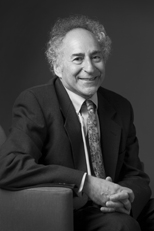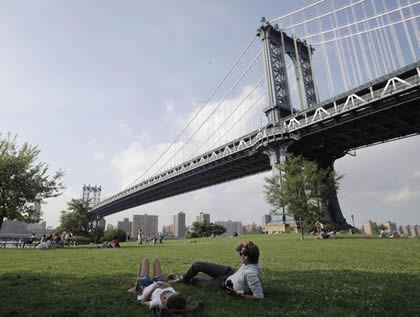Brooklyn Renaissance by Daniel R. Schwarz
“Brooklyn Renaissance,” Ithaca Journal, June 27, 2015, 1D, 8D.-9D
http://www.pressconnects.com/story/life/2015/06/25/brooklyn-renaissance-museums-parks/29290673/
I. Introduction
|
When I was growing up on Long Island, Brooklyn—one of New York City’s five boroughs (the others are Manhattan, Queens, the Bronx, and Staten Island)--was considered a residential borough of New York City rarely visited by suburban or Manhattan dwellers unless their relatives lived there. From my Rockville Centre, Nassau County perspective, Brooklyn seemed a place from which people emigrated to the suburbs and I rarely heard discussion of its history and culture. Later, when I saw single family houses on tree-lined streets in the Flatbush neighborhood, I realized that my stereotype was wrong. With a population of 2.6 million, Brooklyn is the most populous of New York’s boroughs. Were it a city, it would be the fourth most populous in the US behind only the other boroughs of New York City, Los Angeles and Chicago. During the nineteenth century, until consolidated with the rest of the boroughs of NYC in 1898, it was an independent city and one of the largest in the US. “Breukelen” was originally a Dutch settlement but the six original communities were handed over to the British in 1664. The British controlled Brooklyn during the Revolutionary war after George Washington evacuated following the Battle of Brooklyn. In the Civil War Brooklyn was a major supplier to the Union Army. Brooklyn is now a place with many chic neighborhoods—Manhattan Beach, DUMBO, Williamsburg, Park Slope, Cobble Hill--that rival Manhattan in real estate values. It is also home to many art galleries—sometimes in areas less visited by tourists like Gowanus and Bushwick-- and excellent restaurants. Many tourists still never set foot in Brooklyn, and my goal in this piece is to show readers what they are missing. Brooklyn has beautiful streets such as Eastern Parkway--two miles of a tree-lined boulevard--and Ocean Parkway. Both were designed by the same Frederick Law Olmstead who with Calvert Vaux designed Central Park. It also contains architectural wonders of the nineteenth and twentieth centuries. Brooklyn’s main street populated by many businesses is Flatbush Ave. running 9.6 miles (including the Flatbush Ave. extension) to the Manhattan Bridge. Another major street is Atlantic Ave. which runs East-West. Be aware that, while there are areas where streets are numbered, Brooklyn does not have a numerical street grid and you need to be aware of street names.
II. Residential Ethnic Mix
|
Brooklyn has a rich ethnic mix with large communities of Irish, Italians Jews (may of whom are Hassidic), African-Americans, West Indians, as well as those of Asian heritage, Chinese-Americans (over 6 per cent) making up the bulk of the 9.5 per cent of Asian-Americans heritage. The Sunset Park area is known as “Brooklyn’s Chinatown.” Almost 20 per cent of Brooklyn’s population are of Hispanic heritage. Among those of European ancestry, Italian-Americans are the predominant ethnic group in Bensonhurst but are also concentrated in Bay Ridge, Carroll Gardens, and Dyker Heights. Russian-Americans live in Brighton Beach. Irish-Americans live in Bay Ridge, Marine Park and Vinegar Hill, although many have moved to Long Island. Polish-Americans are a major presence in Greenpoint (“Little Poland”). Arab-Americans and other Muslims have been moving into Bay Ridge. West Indians are likely to live in East Flatbush, Canarsie and Kensington. A large Pakistani community lives in the Ditmas Park area. Jews comprise more than 15 per cent of the population and often live in Borough Park, Williamsburg, the Flatbush-Midwood area, and Ocean Parkway. Less religious Jews live in Park Slope, Ditmas Park, and Windsor Terrace. The 75,000 plus Syrian Jews, one of the most insular Jewish communities in terms of marrying and socializing, live mostly in Gravesend. Exploring the various cultures in these ethnic neighborhoods can be educational and great fun.
III. Brooklyn: Defined by Neighborhoods
Brooklyn is a city of neighborhoods, ever-changing but each with its own unique history, often defined by the ethnic and socio-economic groups that currently live there and, in some cases, settled there centuries ago.
Some neighborhoods take their identity from their history. For example. Red Hook was founded by the Dutch in the 1600s. The clay soil is red and hook was the Dutch “hoek,” a word that means “point” because the land projects into Upper New York Bay. A stroll beginning on Rapelye Street, named for one of New Amsterdam’s earliest families, is a way to appreciate Brooklyn’s early history. Red Hook also played a role in the American Revolution, eventually succumbing to the British who controlled the New York metropolitan area from 1776 to 1783. Now Red Hook offers visitors and residents a full view of the Statue of Liberty. The neighborhood also has some splendid art galleries.
Fort Greene is named after a fort in the Revolutionary era built by General Nathaniel Greene. Fort Greene Park was designed by Olmstead and Vaux. The Jewish Children’s Museum in Crown Heights (792 Eastern Parkway) focuses on Jewish themes and is a teaching experience for all children, no matter their background.
One venue to visit is the Brooklyn Historical Society (128 Pierrepont St on the corner of Clinton Street in Brooklyn Heights). Built in 1879-81 and restored 1999-2003 the building is an example of Renaissance Revival style, both its exterior and interior are quite splendid. The Society features some wonderful historic maps of Brooklyn.
IV. The Major Sites
Guided Walking tours can be a fun way to learn about Brooklyn, although you can do the walking on your own.. With many bike paths, especially along the waterfront, renting bikes is another option. MTA subways and public buses offer convenient transportation. You can also find private guided bus tours, but I am not a big fan of these often rushed overviews unless you have medical issues and cannot walk well.
One way to begin exploring Brooklyn is to walk over the Brooklyn Bridge (which begins on the Manhattan side at City Hall) and see wonderful views of the skyline as you approach as well as views of Manhattan. Completed in 1883, it was the first steel-wire suspension bridge in the country. When you cross over the East River you are in downtown Brooklyn, featuring Brooklyn Borough Hall, built in 1846-51 when Brooklyn was a separate city, as it was from 1834 to 1889. Do not miss the waterfront Brooklyn Bridge Park which has integrated some historic sites into its 85 acres. Then walk the scenic Brooklyn Heights Promenade (sometimes called the Esplanade).
Once you cross the Brooklyn Bridge you are in DUMBO (an acronym for the Down Under the Manhattan Bridge Overpass; the Manhattan bridge, built in 19009, connects with Downtown Brooklyn from Manhattan’s Canal Street), a neighborhood that extends form the Brooklyn Bridge to the Manhattan Bridge, which you can walk across, and continues east to Vinegar Hill. For those who enjoy art galleries, DUMBO is a favorite venue. The non-for profit St. Ann’s Warehouse puts on a an array of innovative musical and theatrical events; for the 2015-6 season, it will be moving to its new home in the historic Tobacco Warehouse in Brooklyn Bridge Park. DUMBO also is known for its chocolate shops,
Another nice walk is over the Williamsburg Bridge connecting Delancey street on the Lower East Side with the Williamsburg neighborhood, a diverse neighborhood undergoing gentrification. It is a center of popular music and jazz—including Indie Rock--and has a thriving art community. There is a large Satmar Hasidic community there; on the North Side of Williamsburg is an Italian community.
V. A Wonderful Day in the Prospect Park Area
Prospect Park is a must-visit site. Designed by Olmstead and Vaux, it contains a 52-acre garden and includes a zoo, a nature conservancy, an Audubon center, and the only lake in Brooklyn.
Among treasures that should not be missed are the Brooklyn Museum, the second largest museum in New York; it is in Prospect Heights. Among it many treasures is a fine Egyptian collection and strong holdings in American Art (200 Eastern Parkway, near the Prospect Heights, Crown Heights, Flatbush and Park Slope areas). Designed by McKim, Mead and White in 1895, the original plan was to make it the largest art museum in the world; the planned museum was four times as large as the actual museum that opened in 1897. In my experience it is rarely crowded and a nice place to begin a day in the Prospect Park area
|
Founded in 1910 and located in the Prospect Park neighborhood, the Brooklyn Botanic Garden can be nicely combined with a visit to the nearby Brooklyn Museum. Highlights are the Japanese hill-and-pond garden and the Steinhardt Conservatory, which houses the C.V. Starr Bonsai Museum and other indoor plants.
Brooklyn does not have the density of world-class museums that you will find in Manhattan, but I recommend a visit to the Brooklyn Children's Museum in Crown Heights (145 Brooklyn Ave.). Founded in 1899, it is the first museum in the United States focusing on children.
The Green-Wood Cemetery, in Greenwood Heights (500 25t th. St.)) and walking distance from Prospect Park, is a historic burial site dating from 1838. On beautiful grounds, the cemetery contains elaborate monuments honoring nineteenth century luminaries.
VI. Other Important Sites
Housed in a historic 1936 subway station that is no longer in use, the New York Transit Museum in Brooklyn Heights can be fun for children of all ages, including adults. It presents a history of the New York City transportation system, notably subways and buses.
Near the Beaux Arts Brooklyn Museum and originally a Beaux Arts building begun in 1912, the Central Library of the Brooklyn Public Library’s fifty-eight branches is on Flatbush Avenue and Eastern Parkway on Grand Army Plaza. The Central Branch was redesigned as a superb Art Deco building and reopened in 1941.
A four year college within the CUNY system that is located in Midwood. Brooklyn College has one of the most beautiful campus in the US, as I saw when giving a lecture there some years ago. Its also home to the Brooklyn Center for the Performing Arts that not only hosts a wide variety of musical , dance, and theatrical events, but also serves as an educational center that introduces the arts to children.
|
Once an island, but now due to land fill a peninsula on the water, Coney Island is not only a residential community but has long been famous for its amusement rides, its famous Boardwalk, the New York Aquarium (the oldest continuing operating aquarium in the US and a definite must) and beach. The wooden roller coaster known as the Cyclone, which I road once or twice in the late 1950s or early 1960s is still operating.
Between 1880 and World War II , Coney Island was a vacation and day trip mecca for millions of people per year. Today Coney Island is a destination for beachgoers, families with young children, and group outings. The Coney Island Museum celebrates the area's history, with a particular focus on the amusement park area.
VII. Major Performance Venues
Perhaps the performance center of Brooklyn is BAM (the Brooklyn Academy of Music, 30 Lafayette Ave. ) which puts on a full program of music, dance, and theatre. Its three buildings contain the Howard Gilman Opera House and the Harvey Theatre as well as a Black Box theatre. Over the years I have seen some wonderful Shakespeare here including Kevin Spacey in Richard III.
The Theatre for a New Audience (Ashland Ave between Fulton St and Lafayette Ave) in the Fort Green area is the resident company at the Polonsky Shakespeare Center. They have been hosting the wonderful Fiasco Company’s Two Gentleman of Verona. I have also seen this company do Cymbeline and Measure for Measure
The Gallery Players in Park Slope (199 14t th. St.) is a 99 seat Off-Off Broadway theatre that hosts various innovative productions.
The renovated Kings Theatre in the Flatbush neighborhood (1027 Flatbush Ave) hosts various musical events.
Barclays Center (620 Atlantic Ave. in Prospect Heights) is where the NBA Brooklyn Nets play basketball and where major concerts tale place.
IF YOU GO:
Hotel:
Marriott Brooklyn Bridge is good choice and has the usual amenities of full service hotel.
Restaurants:
Upscale:
Peter Lugar ‘s Steak House has been for generations a mecca for carnivores (178 Broadway, Brooklyn); however, much of the recent online commentary reflects disappointment, perhaps because of the hype and high prices.
Elegant and considered one of New York’s premier dining places, the River Café (1 Water Street) is pricey and has excellent views of lower Manhattan. The restaurant requires a jacket for dinner and prefers a tie, too.
Moderate:
Noodle Pudding is a mid-priced Italian restaurant offering good quality and generous portions in Brooklyn Heights (38 Henry St.).
The Smoke Joint (87 S. Elliot St) is a funky, informal barbecue place that is near BAM and fun after a performance there.
Virtually ever neighborhood has fine local restaurants; I have consulted and quote Kayla Dryden, for several years a resident of Brooklyn, for input on restaurants):
Miriam in Park Slope (79 5th Ave.) is the definition of what a neighborhood restaurant should be. It's equally wonderful for brunch and dinner, has an extremely reasonable wine list, and is good for both groups and date -nights (they take reservations). The food is Israeli and everything is served with homemade, hot pita bread. My favorites are any of the mezes for a light meal or dinner, and the Israeli breakfast plate for brunch. Plus, it's just a few blocks from the new Barclays Center venue.
Some of the best pizza in the city can be found in Crown Heights at Barboncino, which is just a short walk from the Brooklyn Museum or Brooklyn Botanical Gardens on 781 Franklin Avenue. It can be a wait for dinner, but it's also open for brunch and lunch. The pizza is fantastic-- I especially love the white pizza-- but the sides, salads, and cocktails are also excellent. The restaurant has a cozy atmosphere and they have a garden in the back, plus live jazz on Tuesday nights.
Author of numerous travel articles and the well-received 2012 book Endtimes? Crises and Turmoil at the New York Times (Excelsior Editions of SUNY Press, recently released in a new paperback edition).), Daniel R. Schwarz is Frederic J. Whiton Professor of English and Stephen H. Weiss Presidential Fellow at Cornell University. He can be reached at drs6@cornell.edu and followed on twitter at www.twitter.com/danRSchwarz and https://www.facebook.com/SchwarzEndtimes.


 Manhattan Bridge stretching above them, a couple relaxes on the grass at Brooklyn Bridge Park in the DUMBO section of Brooklyn. (Photo by Marcia Jacobson)
Manhattan Bridge stretching above them, a couple relaxes on the grass at Brooklyn Bridge Park in the DUMBO section of Brooklyn. (Photo by Marcia Jacobson) Pedestrians walk through the Fort Greene neighborhood, a rapidly glowing cultural district of Brooklyn located close to Manhattan. (Photo: Getty Images)
Pedestrians walk through the Fort Greene neighborhood, a rapidly glowing cultural district of Brooklyn located close to Manhattan. (Photo: Getty Images) Visitors walk through the roses at the Brooklyn Botanic Garden's Cranford Rose Garden in the Brooklyn. (Photo: AP)
Visitors walk through the roses at the Brooklyn Botanic Garden's Cranford Rose Garden in the Brooklyn. (Photo: AP)
 People wait in line at Nathan's hot dogs at Coney Island in Brooklyn. (Photo: Getty Images)
People wait in line at Nathan's hot dogs at Coney Island in Brooklyn. (Photo: Getty Images)